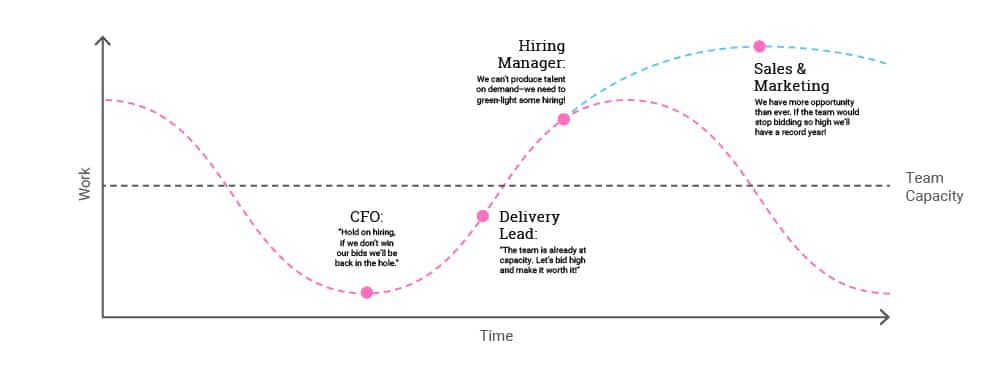Five Steps to Smarter Forecasting
Stop me if you’ve heard this one: Digital services companies like agencies and software development firms are constantly on the roller coaster of too much work or not enough – or too many people or too few to actually do that work! The common question becomes, “Should we just buy pizza and beg everyone to stay late for the next couple of weeks or pull the trigger and hire more help?!” 😵💫
It’s a tough balancing act to bring in enough new business to hit targets, have just the right amount of talent on staff to deliver great results, and keep teams happy and engaged. And oscillating between the ebbs and flows of selling – and profitably delivering – digital services can become tense and messy when people are the product. It leads to reactive decision-making driven by emotion and instinct. We get it, and it’s a tension we see in services companies every day.

But it doesn’t have to be like this! And we believe data is the one ingredient necessary to reduce this volatility. The right data – visible across the organization – can remove emotion and bring more confidence in decision-making and forecasting. Because without accurate data, companies will continue to struggle to get a clear picture of what’s happening across the business, what’s coming down the pipeline, and what they need to do to balance the needs of the business with the needs of their people. Data informs better forecasting, which drives performance and stronger operations.
Here’s how to use data and accurate forecasting to exit the roller coaster.
1. Get visibility into the sales pipeline
Accurate forecasting all starts with visibility into the sales pipeline. Without visibility, there’s no way to know what’s being sold, whether those opportunities are enough to hit financial and operational targets (revenue, margin, utilization), and if you have the right people available to do the work. Sales pipeline data is necessary for all types of business planning, including sales forecasting, revenue forecasting, and resource management for digital services companies.
Unfortunately, most have sales pipeline data locked in the CRM, and it’s not easily shared or visible to operations and delivery teams. And if they don’t have visibility into key data points from the pipeline, they won’t have the necessary context for effective resource planning. They’ll struggle to predict whether they have enough or just the right number of people, in the right roles, to successfully deliver projects.
Plus, new opportunities rarely match resource availability. A lack of visibility often leads to a chaotic and reactive scramble of trying to get the work done with whoever is available at the time — regardless of whether those people are the best fit for the job. Shared sales pipeline data is the first step to creating forecasts that improve business performance.
2. Don’t let precision get in the way of accuracy (or at least consistency)
If sales pipeline visibility is fundamental to business forecasting, keeping the pipeline’s data up-to-date is critical for accurate forecasts. This is understandably challenging for most companies, because data management often falls behind other sales priorities, such as generating new business, serving existing clients well, and making sure the business development team is healthy.
The good news is that salespeople don’t need to put together detailed project or resource plans right away, but they can provide directionally correct data early on and add higher fidelity along the way. More insight is always more valuable than nothing at all. Enforcing data governance can feel like too strict of a requirement and a waste of time, but in reality, regularly updating CRM data will create accurate forecasts that will improve your business performance, making it easier to win good work, serve clients well, and promote positive communication and collaboration between teams.
We recommend adopting these sales operations best practices to keep CRM data current. Without accurate and up-to-date data, forecasts are, at best, inaccurate and useless; at worst, they could lead to the wrong decisions.
3. Implement professional services automation that enables smarter forecasting
Are you piecing together disparate data sources into spreadsheets and trying (but struggling) to use them for sales forecasting, resource planning, and revenue forecasting? One of the main reasons we built Parallax is because we know the pain of outgrowing homegrown tools and processes. If your spreadsheets or custom-built tools have become too clunky, cumbersome, and easily prone to breaking, it’s likely because you’ve reached a growth point where you can’t just wing it and count on your team’s gut instinct and brilliance. You need visibility into real-time data and up-to-date forecasts. But big, clunky tools and ERPs involve too much change and adoption.
Parallax brings your tools and data into one place, so you can create a shared perspective on performance, drive better operations, and leverage data for strategic decision-making. Our integrations-first philosophy means less disruption for sales and delivery teams. They can keep using best-in-class CRM or project management tools. But Parallax augments these great platforms with reporting and insights built specifically to help services companies drive smarter operations, unlock better forecasting, and improve business performance.
4. Forecast against targets and compare to benchmarks
Once your data is in one place and you’ve adopted the habits needed to keep everything accurate and reliable, you can unlock the power of real-time forecasts. These forecasts help leaders make smart, impactful decisions in support of their business and people. Use the software you chose for real-time forecasting and resource planning (we’re completely unbiased about which one 😉) to see how you’re performing on a variety of financial and operational metrics. Compare your performance against industry benchmarks and adopt the best practices necessary to optimize performance.
Not sure where to start? Check out the two KPIs that matter for digital services companies.
5. Make informed decisions that optimize operations and drive business performance
Now that your teams have access to accurate, real-time forecasts, it’s time to use that information to make decisions driven by data rather than emotion. Accurate and reliable forecasts allow for more proactive decision-making, giving your team time to staff projects in a way that allows for growth opportunities for employees and healthy resource management.
You might want to build forecasts that help you:
- Inform resource planning, making it easier to decide when it makes sense to hire (and who to hire) to ensure project success.
- Identify dips in the sales pipeline so you can act accordingly to generate new opportunities.
- Adjust in-progress project plans based on how you’re performing on key metrics.
When you have confidence in your forecasts, your team can make more confident decisions and investments in the future — avoiding the chaotic scramble of the “too much work, not enough work” roller coaster.

Scale the magic that makes you great
You’ve reached a point where accurate data and forecasting are vital to future growth when you can no longer rely on gut instinct to make decisions. It’s a bittersweet problem, but adopting best practices related to resource planning, forecasting, and data governance gives everyone more time to focus on their craft and scale the magic that makes your company great.
At this growth point, your teams must break free from siloed thinking and create a shared perspective. When your team leads can get quick access to accurate forecasting, they can make strategic decisions supporting the business and its people. To learn more about how Parallax brings together data from across the business for better planning and forecasting, get in touch for an assessment of where you’re at and where you want to be.


